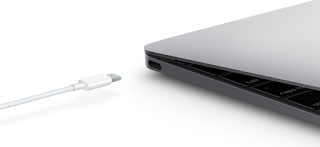USB Typ - C The Future
USB or Universal Serial Bus is the most common and popular interface for connecting variety of devices to computer and it is also the fastest way to transfer huge amount of data from one device to another. We all use USB in our daily life and work whether it is in computers, smartphones, tablets, camera etc. There are various types of USB connectors and ports, in computers we see a larger USB port, in smartphones a tiny one and in printers, scanners and camera a different one. Now here comes new type of USB physical connector / port that is just been released known as USB Type-C, but first let us learn about the various older types of USB ports / connectors.


Details
The USB Type-C connectors connect to both hosts and devices, replacing various Type-B and Type-A connectors and cables with a standard meant to be future-proof. The 24-pin double-sided connector is slightly larger than the micro-B connector, with a USB Type-C port measuring 8.4 millimetres (0.33 in) by 2.6 millimetres (0.10 in). The connector provides four power/ground pairs, two differential pairs for non-SuperSpeed data (though only one pair is populated in a USB Type-C cable), four pairs for SuperSpeed data bus (only two pairs are used in USB 3.1 mode), two "sideband use" pins, VCONN +5 V power for active cables, and a configuration pin used for cable orientation detection and dedicated biphase mark code (BMC) configuration data channel.
Connecting an older device to a host with a USB Type-C receptacle requires a cable or adapter with a Type-A or Type-B plug or receptacle on one end and a USB Type-C plug on the other end. Cable length should be 1.0 m or less. Legacy adapters with a USB Type-C receptacle are "not defined or allowed" by the specification, due to their being able to create "many invalid and potentially unsafe" cable combinations.
Devices
Devices may be hosts or peripherals. Some, such as mobile phones, can take either role depending on what kind is detected on the other end. These types of ports are called Dual-Role-Data (DRD). When two such devices are connected, the roles are randomly assigned but a swap can be commanded from either end. Furthermore, dual-role devices that support USB Power Delivery may independently and dynamically swap data and power roles using the Data Role Swap or Power Role Swap processes. This allows for charge-through hub or docking station applications where the Type-C device acts as a USB data host while acting as a power consumer rather than a source.
USB Type-C devices may optionally support bus power currents of 1.5 A and 3.0 A (at 5 V) in addition to baseline bus power provision; power sources can either advertise increased USB current through the configuration channel, or they can support the full USB Power Delivery specification using both BMC-coded configuration line and legacy BFSK-coded VBUS line.
Cables
USB 3.1 Type-C cables are considered full-featured Type-C cables. They are electronically marked cables that contain a chip with an ID function based on the configuration channel and vendor-defined messages (VDM) from the USB Power Delivery 2.0 specification. Cable length should be 1 m or less. Electronic ID chip provides information about product/vendor, cable connectors, USB signalling protocol (2.0, Gen1, Gen 2), passive/active construction, use of VCONN power, supported VBUS current, latency, RX/TX directionality, SOP controller mode, and hardware/firmware version .
USB 2.0 Type-C cables do not have shielded SuperSpeed pairs, sideband use pins, or additional wires for power lines. Increased cable lengths up to 4 m are supported.
All USB Type-C cables must support 3 A current (up to 60 W); cables supporting high-power 5 A current (up to 100 W) must contain e-marker chips programmed to identify the cable as being 5A capable. USB Charging ports should also be clearly marked with supported power wattage.[11]
Full-featured Type-C cables that support USB 3.1 Gen 2 can handle up to 10 Gbps data rate at full duplex. They are marked with a SuperSpeed+ (SuperSpeed 10 Gbps) logo. There are also cables which support only USB 2.0 with up to 480 Mbps data rate. There are USB-IF certification programs available for USB Type-C products and end users are recommended to use USB-IF certified cables.
Thanks..............
USB Typ - C The Future
 Reviewed by Pradeep maity
on
12:08 AM
Rating:
Reviewed by Pradeep maity
on
12:08 AM
Rating:
 Reviewed by Pradeep maity
on
12:08 AM
Rating:
Reviewed by Pradeep maity
on
12:08 AM
Rating:









No comments